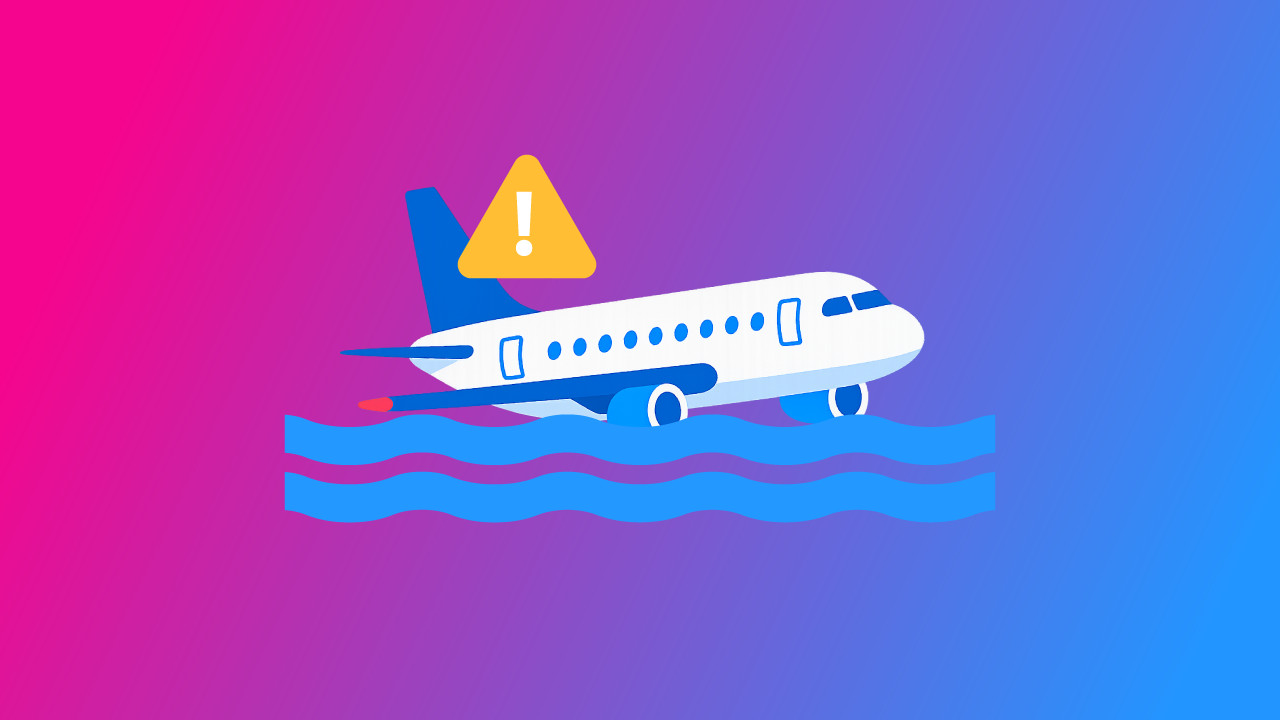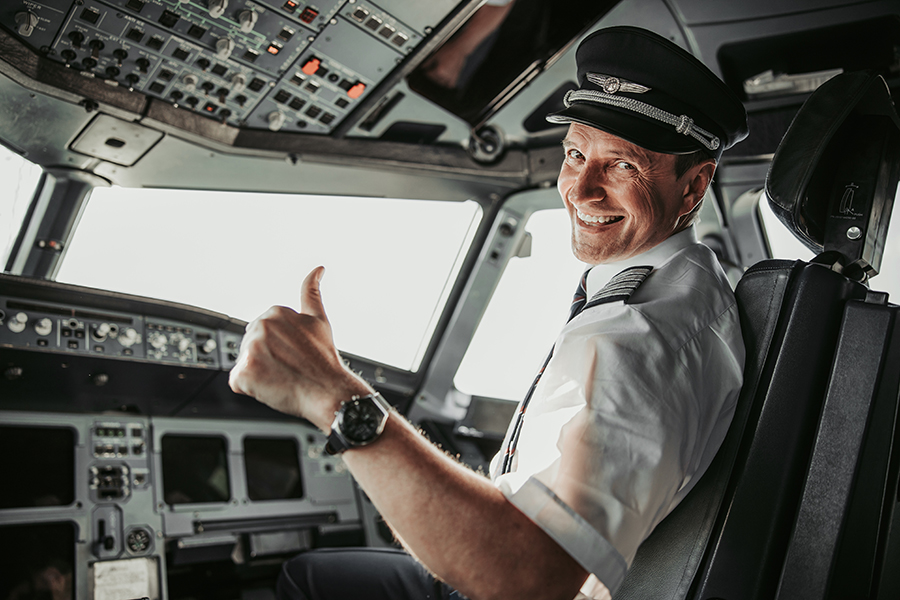-
Key Takeaways
-
What Is a Dutch Roll?
-
Why Does a Dutch Roll Happen?
- How Does Yaw Cause Roll?
- How Does Roll Cause Yaw?
- How Does a Dutch Roll Begin?
- What Happens to the Aircraft in a Dutch Roll?
-
How Does Aircraft Design Affect Dutch Roll?
- Longitudinal Stability
- Directional Stability
- Lateral Stability
- Factors Affecting Dynamic Stability
-
Is Dutch Roll Dangerous?
-
How Do Pilots Prevent or Correct a Dutch Roll?
- Using Piloting Techniques
- Using the Yaw Damper
-
Real-World Examples of Dutch Roll
-
Conclusion
If you’ve ever been on a flight and felt the airplane swaying side to side, you might’ve experienced a taste of what’s known as a Dutch roll.
This movement is a mix of rolling and yawing, and it can be incredibly disorienting. It may feel alarming if you’re not sure what’s happening.
But it’s not something that occurs without reason. Dutch rolls usually happen in larger, swept-wing aircraft. Modern aircraft have systems to prevent them from becoming dangerous. Still, they can occur, especially in certain flight conditions.
Learning about the Dutch roll can make your next flight feel a little more grounded, even when the airplane isn’t.
Let’s get started!
Key Takeaways
- Dutch roll is a coupled yawing and rolling oscillation triggered by an initial disturbance.
- How an aircraft handles Dutch roll depends on its dynamic stability.
- The aircraft’s design influences its dynamic stability.
- Dutch rolls are usually not dangerous. However, they can lead to control difficulties, discomfort, and, in extreme cases, loss of control.
- Large aircraft use yaw dampers while small aircraft rely on piloting techniques to counter Dutch roll.
What Is a Dutch Roll?
An aircraft performing a Dutch roll is simply swaying as it flies along. The name comes from ice skaters’ swaying movements, particularly the Dutch style of skating on frozen canals.
A Dutch roll is a repetitive motion, or an oscillation, where the aircraft’s nose and wings move in opposite directions.
When the aircraft rolls to the right, the nose yaws to the left, and vice versa. If you follow the motion of the nose, you’ll note it moves in a figure-eight pattern.
Why Does a Dutch Roll Happen?
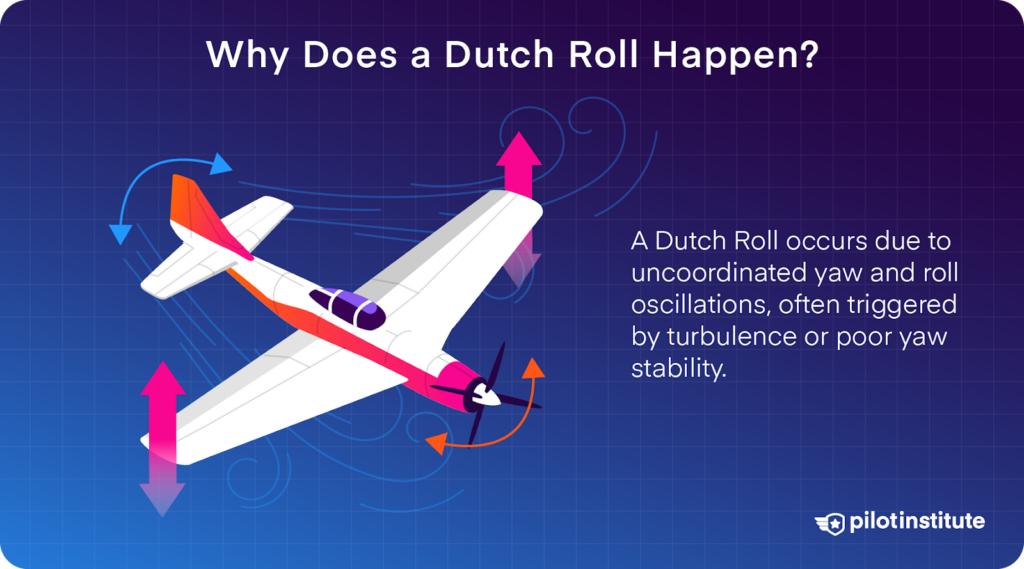
The Dutch roll essentially is a cycle involving only two steps. There’s a yawing motion followed by a rolling motion followed by a yawing motion followed by a rolling motion followed by… You get the idea.
These two steps follow each other closely because each action causes the other action to occur. Yaw causes roll, and roll causes yaw. This interaction is called roll-yaw coupling.
How Does Yaw Cause Roll?
Yaw has a primary effect, which is to rotate the aircraft about the vertical axis. It swings the aircraft’s nose around and changes the heading.
A consequence of the rotation is that the outer wing swings forward, covering more distance than the inner wing in the same period.
The outer wing generates more lift than the inner wing since it’s temporarily moving faster. Extra lift makes the wing rise. With one wing higher than the other, the aircraft has entered a bank and is now in a roll.
How Does Roll Cause Yaw?
Increased lift on the raised wing immediately creates more induced drag.
What’s induced drag?
Induced drag is the resistance that happens as a result of creating lift, caused by swirling air around the wings that slows the airplane down.
The higher drag on the raised wing reduces its speed relative to the lower wing. This makes the lower wing swing forward, producing a yaw in the opposite direction.
How Does a Dutch Roll Begin?
Typically, a Dutch roll starts with a yawing motion first.
What causes the initial yaw?
The trigger can be any external force such as a wind gust or turbulence. The aircraft’s response to the initial disturbance determines whether or not it enters a Dutch roll.
To understand the aircraft’s response to a disturbance, you need to understand aerodynamic stability.
There are two main types of stability: Static and Dynamic stability.
- Static stability gives you the aircraft’s initial response to a disturbance.
- Dynamic stability determines the aircraft’s behavior once it starts oscillating.
Let’s start by understanding Static stability.
- Statically stable: This type of aircraft tries to counter the disturbance and maintain its original state. For example, if a statically stable aircraft gets blown off course by a gust of wind, it tries to return to its original heading without pilot input.
- Neutrally stable: This type of aircraft would simply continue in the new direction the disturbance directs. For example, if a gust changes the heading by 10 degrees, the aircraft continues 10 degrees off course.
- Statically unstable: This type of aircraft amplifies the initial disturbance. It moves progressively further away from its original flight path. So even though the initial heading change was only 10 degrees, the instability takes it beyond 10 degrees and worsens.
Dutch rolls exist in statically stable aircraft because they try to self-correct after a disturbance. They don’t quite make it back to their original orientation, which is why the oscillations appear.
What Happens to the Aircraft in a Dutch Roll?
What happens to your aircraft once it starts oscillating?
The oscillations can either increase (amplify), decrease (dampen), or stay the same. Their behavior depends on the aircraft’s dynamic stability.
Let’s understand the types of dynamic stability.
- Dynamically stable: Dutch roll oscillations for this type of aircraft gradually decrease in amplitude. The aircraft will return to a steady level flight without needing much input from the pilot. That’s ideal for passenger comfort and flight safety.
- Dynamically neutral: Oscillations continue at the same intensity over time for dynamically neutral aircraft. They neither grow nor diminish and will continue until the pilot actively corrects them.
- Dynamically unstable: For this type of aircraft, the oscillations will grow stronger over time. Without intervention, this could result in an increasingly uncomfortable or dangerous situation. It will require either the pilot or an automated system to intervene to stop the situation from worsening.
Aircraft manufacturers try to shape the aircraft’s design to promote dynamic stability.
How Does Aircraft Design Affect Dutch Roll?
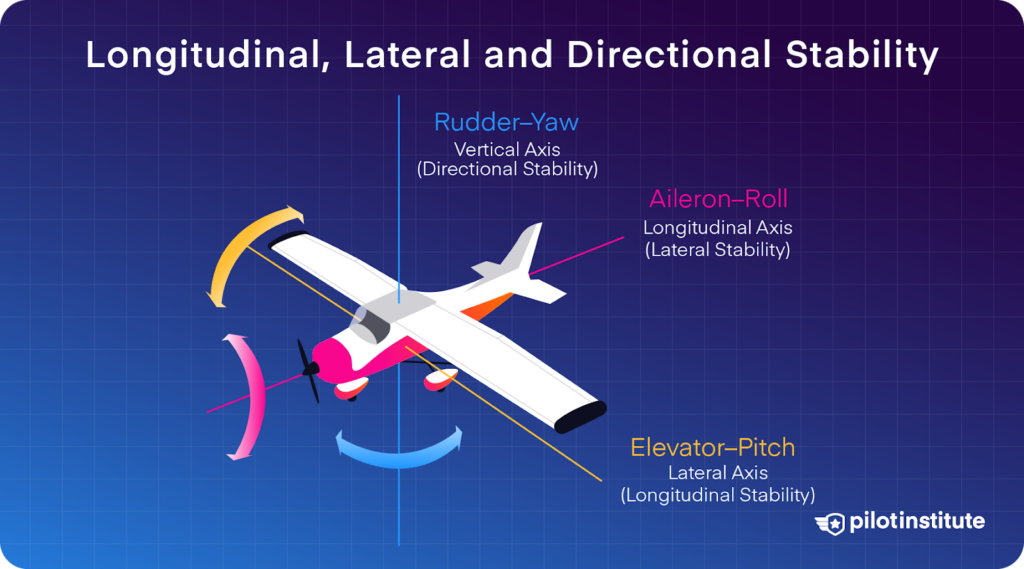
We mentioned that statically stable aircraft try to self-correct from a disturbance. Most aircraft have features built into their design that promote this static stability in all three axes.
Longitudinal Stability
Longitudinal stability exists about the pitch axis. This determines how the aircraft reacts to changes in its nose-up or nose-down attitude.
Placing the center of gravity ahead of the aircraft’s center of lift improves longitudinal stability. The aircraft’s horizontal stabilizer (tailplane) creates a downward lift to counterbalance pitching moments.
Directional Stability
Directional stability decides how stable the aircraft is about the yaw axis. This counters any unintended yawing motion that might swing the nose left or right.
The aircraft’s vertical stabilizer (tailplane) prevents the aircraft from veering off course.
Lateral Stability
Lateral stability exists about the roll axis. Most aircraft feature dihedral wings, which help the aircraft roll back to level flight after a disturbance.
Aircraft like the Cessna 172 have wings mounted above the fuselage. Doing so provides more lateral stability since the aircraft’s Center of Gravity (CG) lies below the wings. This helps return the aircraft to a level attitude after a roll.
Low-wing aircraft such as the Piper PA-28 have relatively less natural lateral stability.
Aircraft designers try to find the right balance for stability in all three axes. For example, aircraft with large vertical stabilizers only experience small and quick Dutch rolls that die out in just a few cycles.
However, if the aircraft has an oversized tail but not enough dihedral in the wings, it becomes vulnerable to spiral instability. If you place that aircraft in a turn, it’ll try to increase the bank angle on its own unless the pilot takes corrective action.
Most aircraft manufacturers strike the balance in favor of spiral instability rather than the Dutch roll. That’s because spiral instability is easier for a pilot to detect and correct. It’s less taxing on the pilot than managing constant Dutch roll oscillations.
Plus, spiral instability has a slow and gradual effect. It doesn’t produce any abrupt motions, so it’s less disruptive to passengers than the Dutch roll.
Factors Affecting Dynamic Stability
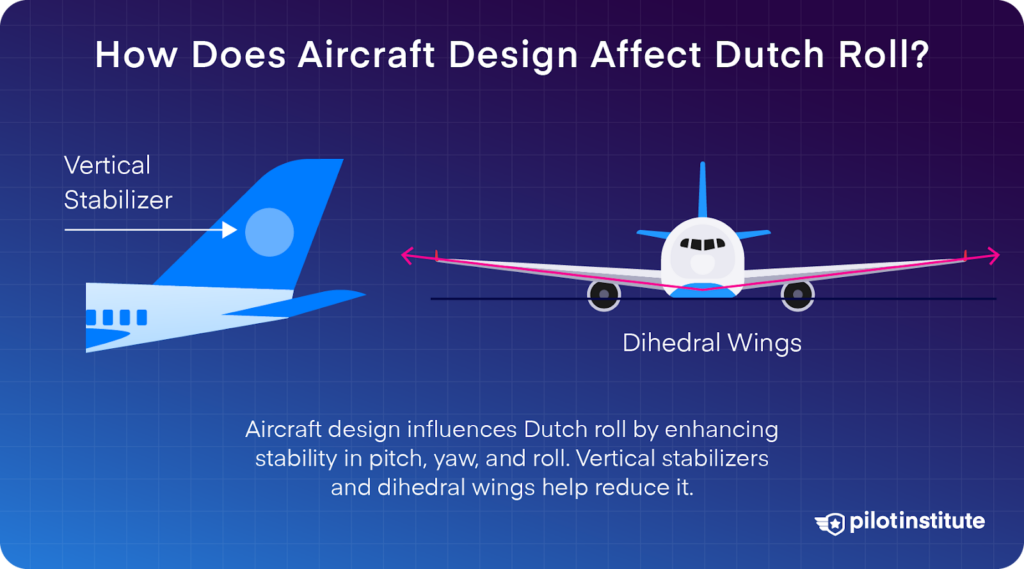
Wing Design
Aircraft wings often include dihedral. This means the wings are angled slightly upward, with the wingtips higher than the wing root.
Dihedral wings respond to sideslip (yaw) by creating a rolling motion away from the sideslip. This resists the sideslip and helps return the aircraft to level flight.
While that’s great for dynamic stability and countering the initial yaw, the rolling motion can promote Dutch roll.
Most commercial airliners have wings that are swept backward to allow them to fly close to the speed of sound safely. Swept-winged aircraft are particularly affected by Dutch rolls. The angled wings create greater differential lift when the aircraft yaws than straight wings.
Tail Design
Larger, more effective stabilizers provide stronger restoring forces. This helps manage dynamic stability in pitch (for longitudinal stability) and yaw (for directional stability).
Center of Gravity
The location of the CG relative to the center of lift and other aerodynamic forces impacts dynamic stability. If the CG is too far aft, for instance, it can make the aircraft more dynamically unstable. This causes greater difficulty in controlling oscillations over time.
Mass Distribution and Inertia
The aircraft’s mass distribution, especially in relation to its CG, affects how quickly it responds to disturbances. High mass or inertia can make the oscillations slower but harder to stop. Lighter designs might react quickly but settle more easily if dynamically stable.
Flight Control Systems
Modern aircraft often rely on fly-by-wire systems or yaw dampers to maintain dynamic stability. They’re especially used in statically unstable designs like fighter jets. These systems make constant adjustments to maintain stable flight. They’re able to dampen oscillations before they grow out of control.
Is Dutch Roll Dangerous?
Most commercial and general aviation aircraft are designed to be dynamically stable. The Dutch roll generally only lasts for a few oscillations and dies out fairly quickly.
For many aircraft, it’s nothing more than a nuisance, and passengers might not even feel it. In some situations, the movement can make passengers queasy, especially those seated near the aircraft’s rear.
Dutch rolls may not seem very dangerous on their own. But, they can easily develop into more serious oscillations if left unchecked or if mishandled by the pilot.
Continuous oscillations can disorient pilots, especially in instrument conditions (IMC). A disoriented pilot may make incorrect control inputs, unsettling the aircraft even more.
Severe oscillations can stress the airframe and control surfaces, potentially damaging them. In extreme cases, the pilot may lose control of the aircraft entirely.
How Do Pilots Prevent or Correct a Dutch Roll?
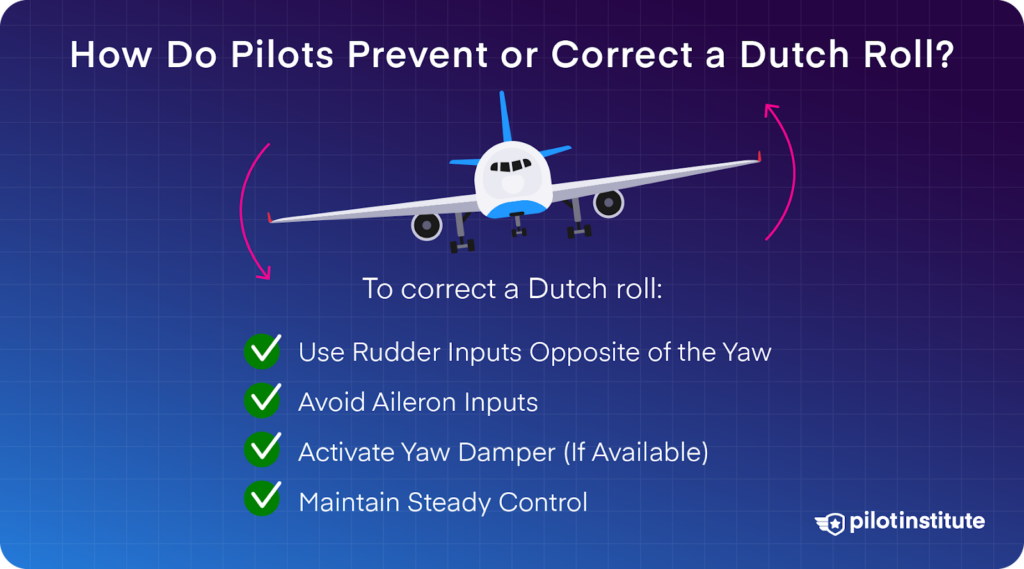
The easiest way to prevent a Dutch roll is by keeping the aircraft coordinated at all times, especially while turning. Keep a close watch on the turn coordinator and ensure the ball stays in the center throughout the turn.
When maneuvering, make gentle inputs that don’t unsettle the aircraft.
However, in some cases, the initial yawing disturbance can be unavoidable. A jolt from the side can trigger a Dutch roll when flying in gusty crosswinds or heavy turbulence.
Using Piloting Techniques
Most of the work involved in eliminating Dutch roll is carried out by the aircraft’s design. Pilots can simply wait a few seconds for the oscillation to subside on its own.
Sometimes, though, the pilot may be trying to maintain a heading or track a localizer and would have to act to suppress the Dutch roll immediately.
To correct a Dutch roll, pilots should apply opposite rudder to the yaw direction to help dampen the motion. If the pilot overcompensates or mistimes the inputs, the oscillation can get worse.
Make small, measured control inputs to prevent any chance of losing control. Once the yaw dampens, gradually reduce rudder input to neutral.
Pilots should avoid using the ailerons to correct the Dutch roll in small aircraft.
Why?
It’s very tempting to counter the roll with ailerons. However, using ailerons alone can actually make things worse by increasing the roll-yaw coupling.
The problem is that It’s very easy to mistime the aileron input and aggravate the roll. The pilot should use minimal ailerons coordinated with rudder input only if excessive oscillations occur.
Some jet aircraft with swept wings do require a sharp aileron input towards the rising wing to escape the Dutch roll. In these aircraft such as the Boeing 727, the use of the rudder for recovery was discouraged.
Using the Yaw Damper
Large aircraft such as commercial airliners, especially those with swept wings, use a yaw damper to counter Dutch roll.
What is a yaw damper?
A yaw damper is a flight control system that automatically applies small, corrective rudder inputs.
Commercial airliners need yaw dampers due to their large size and high cruise speeds. Even small oscillations can be uncomfortable for passengers. That’s why yaw dampers are necessary for a smooth flight experience on airliners.
Having a yaw damper also reduces pilot workload, especially in turbulence, and prevents fatigue on long flights.
Yaw dampers are typically turned off for takeoff and landing in many aircraft. The pilot is responsible for ensuring they’ve activated the yaw damper when required.
Real-World Examples of Dutch Roll
Most incidents related to Dutch roll happen due to incorrect recovery or recognition of the problem, not the Dutch roll itself.
Dutch roll events in large modern aircraft are rare, thanks to advanced aircraft design and the presence of yaw dampers. Pilots still train for Dutch roll recovery in the event of yaw damper failure.
In May 2024, a Southwest Boeing 737-8 MAX experienced a significant Dutch roll while flying from Phoenix to Oakland. Even though the FAA rated it as an accident, the passengers on the aircraft didn’t even notice the oscillations.
The aircraft landed safely with no injuries, but damage to the tail section was found after landing. This was unusual since a modern airliner, equipped with a yaw damper to prevent such motions, shouldn’t have experienced a Dutch roll.
In 1959, a Boeing 707 crashed while on a training flight demonstrating Dutch roll maneuvers. The cause of the fatal crash wasn’t the Dutch roll itself.
Instead, the loss of control happened due to oscillations induced by the pilot trying to recover the aircraft. The resulting stress was so great that three out of four engines detached from the aircraft.
In 2013, a military KC-135R broke up in flight after the crew failed to recognize a Dutch roll and applied inappropriate rudder pressure. This produced extreme airframe stress that separated the aircraft’s tail in flight.
Conclusion
So, why should you care about Dutch rolls?
For most passengers, it’s just a mild wobble, but for pilots, it’s something they constantly have to monitor.
The airplane’s design and tech usually prevent excessive oscillations. Knowing what a Dutch roll is gives you a clearer image of the complex mechanics that provide safety in the sky.
In rare cases, like some high-profile incidents with the Boeing 737 MAX, Dutch roll can worsen beyond a wobble. At that point, pilots must intervene.
Either way, next time you feel that subtle swaying, you’ll know you’re witnessing an important part of aerodynamics at work.
These concepts may seem technical. But, they are why modern aviation runs effortlessly, even in bumpy skies.

